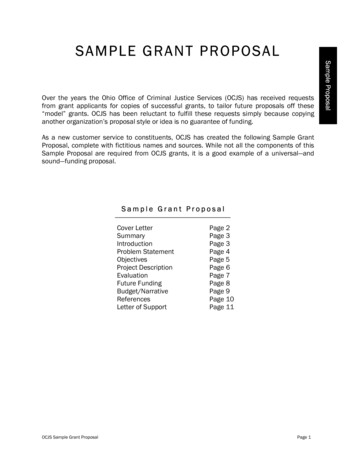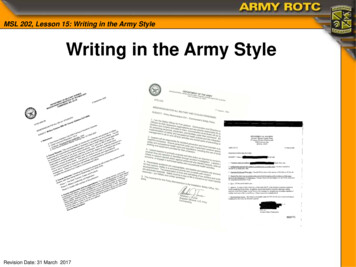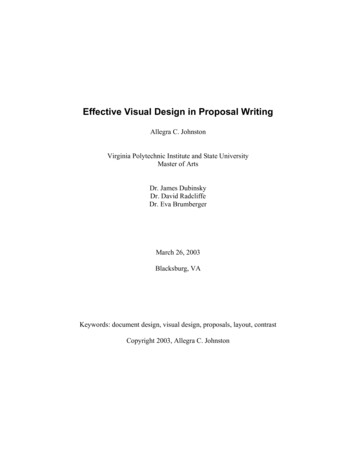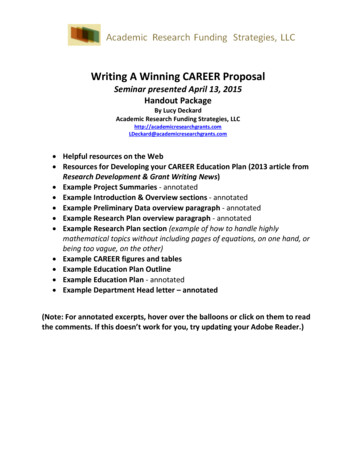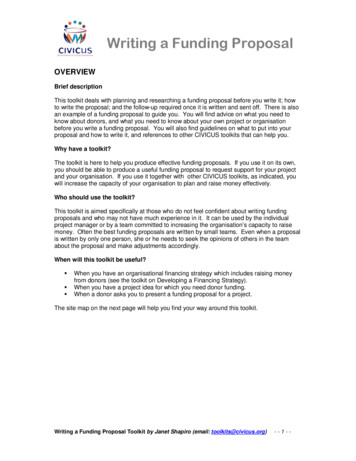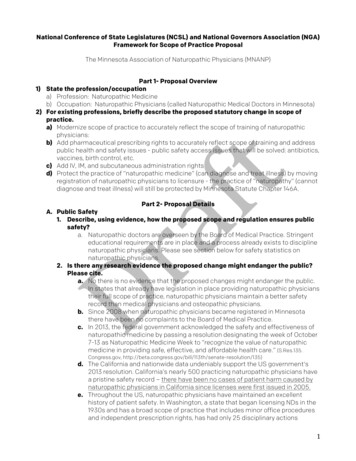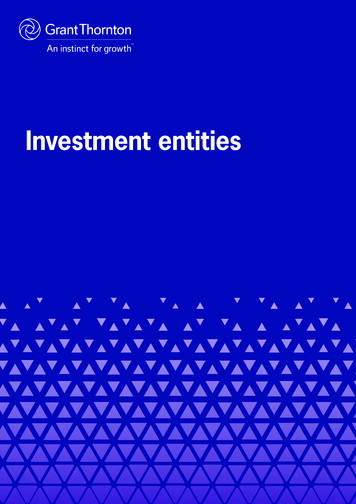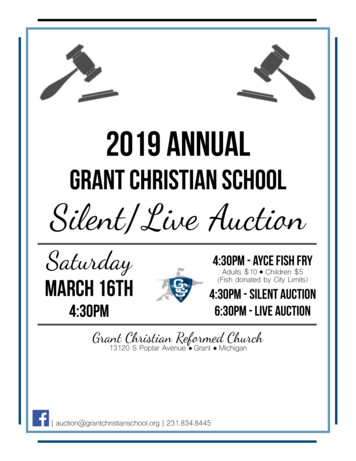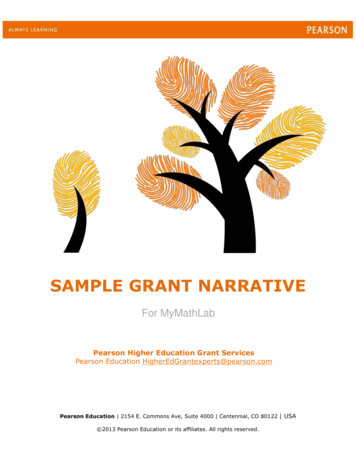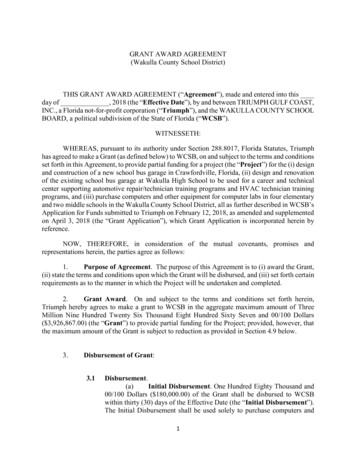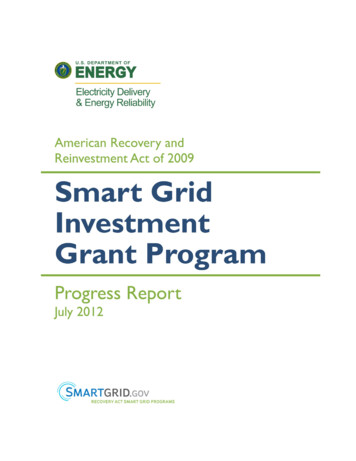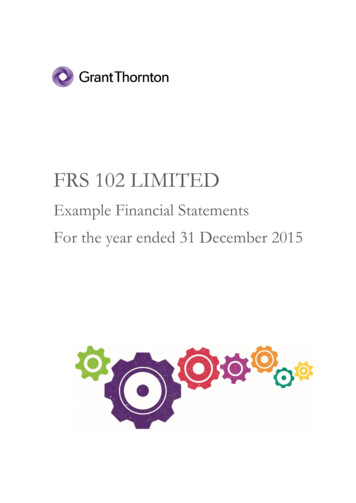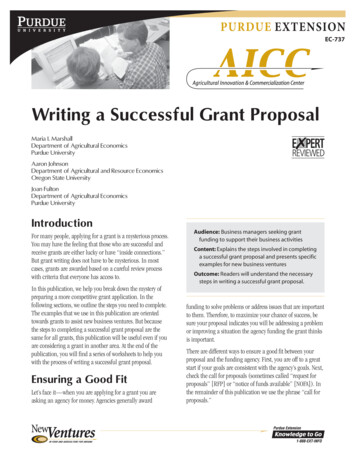
Transcription
Purdue ExtensionEC-737Writing a Successful Grant ProposalMaria I. MarshallDepartment of Agricultural EconomicsPurdue UniversityAaron JohnsonDepartment of Agricultural and Resource EconomicsOregon State UniversityJoan FultonDepartment of Agricultural EconomicsPurdue UniversityIntroductionFor many people, applying for a grant is a mysterious process.You may have the feeling that those who are successful andreceive grants are either lucky or have “inside connections.”But grant writing does not have to be mysterious. In mostcases, grants are awarded based on a careful review processwith criteria that everyone has access to.In this publication, we help you break down the mystery ofpreparing a more competitive grant application. In thefollowing sections, we outline the steps you need to complete.The examples that we use in this publication are orientedtowards grants to assist new business ventures. But becausethe steps to completing a successful grant proposal are thesame for all grants, this publication will be useful even if youare considering a grant in another area. At the end of thepublication, you will find a series of worksheets to help youwith the process of writing a successful grant proposal.Ensuring a Good FitLet’s face it—when you are applying for a grant you areasking an agency for money. Agencies generally awardAudience: Business managers seeking grantfunding to support their business activitiesContent: Explains the steps involved in completinga successful grant proposal and presents specificexamples for new business venturesOutcome: Readers will understand the necessarysteps in writing a successful grant proposal.funding to solve problems or address issues that are importantto them. Therefore, to maximize your chance of success, besure your proposal indicates you will be addressing a problemor improving a situation the agency funding the grant thinksis important.There are different ways to ensure a good fit between yourproposal and the funding agency. First, you are off to a greatstart if your goals are consistent with the agency’s goals. Next,check the call for proposals (sometimes called “request forproposals” [RFP] or “notice of funds available” [NOFA]). Inthe remainder of this publication we use the phrase “call forproposals.”
Check and see if the objectives for this particular grantcoincide with your objectives. Keep in mind that there aredifferent objectives. For example, sometimes job creation isthe goal, while another time increased regional income is thefocus. While job creation and increased regional income arerelated, it is possible to have higher income in the region withno new jobs. Therefore, it is critical that you identify whatoutcomes are important for this agency and this grant proposaland make sure your proposal addresses these objectives.So, what do you do if your project is not a good match for aparticular agency and grant? Sometimes, you may be able toeffectively change your proposal to meet the expectations ofthe funding agency. But be careful! It is easy to fool yourselfExample: Jane’s WineryJane owns a small winery. Her business currently involves a vineyard and wine production. All of her current sales are throughdistributors. She would like to open a tasting room and sell herwine directly to consumers, but she is not sure if there is sufficient consumer demand to be successful. Jane is going to applyfor a grant from a government agency to fund market researchto determine the market feasibility of her business idea.The call for proposals from the government agency is as follows:The objective of this research is to identify an array of innovative marketing strategies to increase sales of agricultural andrelated products. The research will assess and evaluate thetype, size, and location of market opportunities and enablethe decision maker to develop strategies to gain entry intothese markets. Examples of appropriate topics for researchinclude, but are not limited to: Assessment and Specification of Marketing Opportunities, Development of MarketingSystems, and Development of Innovative Real-Time Systems.Because Jane’s project involves the assessment and specificationof the market potential for direct sales of wine from a tastingroom, it is a very good fit for this funding agency. This is furtherconfirmed after she watches a Webcast of a presentation by theprogram administrator and during a brief phone conversationwith the program director. Knowing that her interests alignwell with the program, she is now curious as to how well herproposed idea will score with the proposal reviewers. into believing you have made all necessary changes to fit thecall for proposals. However, the people reviewing the proposalscan quickly figure out that you are really trying to “fit asquare peg in a round hole” and place your proposal towardsthe bottom of the pile.Also, be sure to protect your integrity. Determine what yourgoals are and what you want to do. Make sure that theproposal you submit is consistent with your goals. If you haveto adjust your proposal so much that you sacrifice your coregoals and objectives, you will not only have tarnished yourintegrity, but you won’t be successful in the long run.If your proposal is not a good fit for the grant, look for otherfunding sources rather than prepare a proposal with littlechance of success. Just because you decide not to develop aproposal now does not mean that you have given up on yourproject. You are simply looking for another funding sourcethat is a better fit.Proposal PreparationBefore you begin to write your proposal, there are several stepsyou should take to prepare. Although the temptation is strongto immediately begin writing, your proposal will be muchmore effective if you do some “homework” first.List Goals and Objectives of theProgramBegin by determining the priority areas of the funding agency.Carefully examine the call for proposals, because the goalsand objectives of the specific grant are often explicitly listedthere. Also, pay attention to what the granting agency is doingand what they are saying publicly. Take a look at recent pressreleases from the funding agency. Review recent speeches orpublic presentations given by leaders from that agency. Youwill gain important insight about their priorities.Of course you don’t have to follow through on every one of theabove suggestions, but gathering background informationfrom different sources is a useful way to identify the goals ofthe program. When you have a clear sense of what the agencyvalues, you can adapt your proposal accordingly. We haveprovided a worksheet to help you capture the agency’s goalsand objectives, and determine how your proposal fits them(Agency’s Goals worksheet, p. 7).Purdue Extension Knowledge to Go
List Proposal Evaluation CriteriaMost grants have specific criteria that the reviewers use forevaluating all of the proposals. These criteria are oftenexplicitly stated in the call for proposals. Reviewers areinstructed to evaluate all of the proposals accordingly. In someinstances, the number of points that the reviewers couldpotentially assign to each criterion is also listed. Make sure thatyour proposal matches the criteria set out by the funding agency.As you are preparing your proposal, pay careful attention tothese criteria. Put yourself in the position of a reviewer, andevaluate how well you would rate your proposal according toeach criterion. We have provided a worksheet for you to listthe evaluation criteria and rate your own proposal based onthem (Evaluation Criteria worksheet, p. 8).Seek ClarificationWhen you first read the call for proposals, you may have thefeeling that it is filled with jargon, and, if so, you are notalone. Grant programs often have a set of definitions andlanguage that are unique to that program. To assist you, thereis usually a list of definitions somewhere in the call forproposals. After reviewing the list of terms, you may havequestions about terminology, as well as other aspects of thegrant. If so, write them down.Once you have your questions written down, you are ready tocall or e-mail the contact person at the funding agency. Thename and contact information are usually listed in the call forproposals. Often, the preferred form of contact (e.g., e-mail ortelephone) is also listed. Naturally, it is a good idea to use thepreferred form of contact. The contact person at the fundingagency will be very pleased to work with you if, when you call,your questions are well thought out and written down. Afterall, the agency wants to award grants to people or organizationsthat take preparing the proposal seriously because that is a signthat you can complete good work and meet their stated goals.List Tasks to Be AccomplishedPreparing a grant proposal is often an involved process. Beginby developing a plan of attack. We suggest you generate a listof tasks and assign different members of your team todifferent tasks, along with specific due dates. This will helpyou monitor the progress of your grant proposal.Then begin to execute your plan. In laying out the plan,consider what things you have control over and what thingsExample: Evaluation Criteria for Jane’s WineryJane explores how highly her idea will rate with the programreviewers by having an objective person score her idea based onthe program’s criteria. The call for proposals from the governmentagency lists the following evaluation criteria and possible points. Feasibility: (0-15 points)Are the stated objectives logical, and will they lead towardproving the type, size, and location of the market opportunities? Does the research plan offer an original and innovativeapproach to the problem? Can the research plan reasonablybe completed in the requested grant period? Importance of the Problem: (0-15 points)Does the proposal provide sufficient justification for theimportance of the problem and clearly indicate the anticipatedcommercial potential of the proposed research? Investigator and Resource Qualifications: (0-10 points)Is adequate bibliographic information provided to document that the project director, other key staff, and any consultantshave the appropriate training and experience to carry out theproposed research plan? Budget: (0-3 points)Is the budget appropriate for the proposed research plan,and is sufficient budget detail provided to indicate clearlyhow the funs would be used? Commercial Potential: (0-5 points)Does the proposal provide sufficient explanation of thecommercial potential for the project?Jane fills out the Evaluation Criteria form, detailing how her project fits the scoring criteria of the program. She believes—andthe person helping her critique her proposal confirms—thather only weak area is the “Importance of the Problem,” which isnot clearly defined. Therefore, she has decided to rewrite thatsection of the proposal.Purdue Extension Knowledge to Go
you don’t. In addition, pay attention to those things that mustbe done before you can complete subsequent tasks. Put thetasks in the proper order, and start gathering the externalitems sooner rather than later. Remember that in most casesdue dates for grant proposals are final. If your proposal is late,it will be eliminated no matter how good it is. Good planningis key to on-time delivery.new team members to fill those “holes.” Sometimes, partnersbring matching funds, and it is important to document thatin your proposal. Other times, partners bring essentialtechnical expertise, and you can demonstrate that by describingthe activities your partners will take leadership on. Also, makesure a letter of support from each partner is provided thatexplicitly states his or her intended contribution.Writing the ProposalWhen you write your proposal, you need to demonstrate to thereviewers that you have all of the components in place. Youalso want to highlight how the team will be able to worksuccessfully together. For example, by highlighting thesuccess of previous work, you can demonstrate that your teamis action-oriented and will make sure to deliver on deadlines.To demonstrate that you have the necessary expertise on yourteam, you may want to insert a section that highlights themain skills and experience of each team member and identifyhow that team member will contribute to meeting theobjectives of the project.Many funding sources are highly competitive and only fund asmall percentage of applications. A top-quality proposal, onethat gets funded, delivers a logical and consistent messagethat matches the evaluation criteria laid out in the call forproposals, involves a team that is well qualified for theproposed work and has a positive track record, and includes abudget that is appropriate for the work proposed.The text that you write is the “guts” of your proposal. A topquality proposal contains a message that is easily understoodand believable. This message must be convincing to thereviewers. Keep in mind that reviewers are often reviewingmany proposals and that one way to make it easier for areviewer to go through your proposal is to present yourinformation in a consistent format. When the funding agencysuggests a format in the call for proposals, follow it. Sometimes you can find a template for a particular grant on theInternet. If you do use a template, make sure you check forcompleteness, because, after all, you are the one responsiblefor what you submit. In the following sections, we cover fourkeys to success in writing proposals in more detail.Priority ProblemDraft, Review, Edit, and RepeatThere are some things you can do to make your proposaleasier for the reviewers to read. A happy reviewer is usually amore positive reviewer. Make appropriate use of headings andsub-headings. When possible, ensure that your headings andsub-headings correspond to the sections identified in the callfor proposals. This makes it easier for the reviewers to findspecific sections. It is often helpful to support your text withfacts and figures. Make sure that your data is current, and citethe sources for facts and figures. Failure to do so can causethe reviewer to question your ability and integrity.PartnershipsYour first draft will not yield a proposal that is easy to read.You need to plan on writing and rewriting your proposalseveral times. Each round of editing moves the proposal onestep closer to a proposal that is easy to read. During theprocess, be sure to get feedback from others who are not afraidto be totally candid with you. Wouldn’t you rather have yourfeelings hurt a bit during the writing and rewriting processthan not get selected for funding because your proposal wasweak? You may also want to get assistance from an editor whohas experience putting proposals together.One person cannot do everything or be all things to all people.Therefore, you need partnerships to complete most projects,and developing linkages with appropriate partners can be akey to success. Identify the weaknesses in your team, and seekThere are many different things that you have to do whenwriting a grant, and it would be easy to get caught up indoing all of those and leave the actual writing of the text untilthe last minute. This is not a wise use of time. Usually,By this point, you should know that the project that you areproposing addresses a problem that is a priority with thefunding agency. As noted earlier, you are asking this agencyfor money, and the agency wants to direct money towardsproblems that they deem important. Make sure that the text ofyour proposal is written so that the reviewers can easily seehow your project addresses the agency’s priority. Purdue Extension Knowledge to Go
reviewers spend the majority of their time evaluating thewritten text, so make sure your text is well written. Wellwritten text is free from spelling and typographical errors. Itflows easily and is a pleasure to read.Developing the BudgetThe budget is a critical piece of any grant proposal. Inpreparing your budget, be careful to satisfy all criteria laid outin the call for proposals. Some items (e.g., capital items) arenot allowable expenses. Often, a maximum budget value isidentified in the call for proposals. Make sure that your budgetrequests are reasonable and calculated/estimated (as opposedto guessed). Reviewers can sense when numbers are made up.Keep in mind that the reviewers of your proposal understandthat it costs money to make things happen, so you don’t needto apologize when you include costs that are fair.There are different ways that you will communicate yourbudget in your proposal. The funding agency may provide aspecific budget form for you to complete. You will most likelyalso need to write a budget narrative that is included in the textof the proposal. Keep the budget narrative succinct and to thepoint, providing just enough information to build credibility.Pulling It All TogetherBy now, you know that there will be several components toyour grant proposal. For some components, you will have tosimply fill in the blanks on different forms. For others, youwill have to write a narrative to explain your ideas. Paycareful attention to the components that you are responsiblefor but have no control over, such as letters of support andpartnership commitments. These are critical to your success,but you are dependant on others for them. Be aware ofdeadlines, and notify others of deadlines when you ask foroutside assistance.DocumentsThe call for proposals usually gives detailed instructionsabout the packet you need to put together as your submission.It is important to get this packet correct. Some grantingagencies are very strict, and applications that are missingeven one element or contain an incomplete element will notbe considered for funding. Don’t put yourself into the positionof having done all the work to prepare a great proposal but,because you missed submitting one component (e.g., budget narrative), having your proposal moved to the “Incompleteproposal, do not consider further” pile.Your application packet will include items like a cover page, atable of contents, project narrative, budget and budgetnarrative, reference list, and bios/resumes of key personnel.The grant announcement will identify which components arerequired. Keep in mind that the program administrators oftentake this list and generate a checklist that they and thereviewers use to sort through and rank hundreds of proposals.Also, your instructions may include requirements on thenumber of copies of the application you need to submit. Onceagain, be sure and deliver exactly what they ask for.Matching FundsSome grants require matching funds, and those grantsusually require verification of funds available. There are ofteninstructions on how to provide that verification. If you havefurther questions, this is something you can add to your list ofquestions to ask the program contact person.Letters of SupportLetters of support and partnership commitments are critical toyour success, but you are dependant on others for them. Notethat it is your job to solicit and submit any letters of support.You can even go so far as to draft the letter for people so thatall they have to do is edit the letter and print it on theirletterhead. The Letters of Support Plan worksheet (p. 9)willhelp you keep track of the letters you want to include in yourproposal.Meet the DeadlineGenerating your own checklist helps you understand all of thecomponents necessary for a complete grant proposal package.The Application Package Checklist (p. 10) will help youdevelop your list.Regardless of the tasks you need to complete, start by developing a plan of work, and begin to execute it. Consider whatthings you have control over and what things you don’t. Putthe tasks in sequential order, and start gathering the externalitems as soon as possible. Remember that the final deadline isfinal. When you put your plan together, back schedule fromthe final deadline, and determine your own deadlines forspecific tasks. The r
When you first read the call for proposals, you may have the feeling that it is filled with jargon, and, if so, you are not alone. Grant programs often have a set of definitions and language that are unique to that program. To assist you, there is usually a
